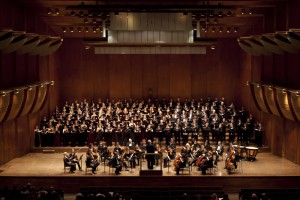One of my main memories of the first half of this varied musical afternoon is garnering a deeper sense of the sonic possibilities of a choral concert. And that is saying a lot, considering I was in attendance at Avery Fisher Hall, an acoustical space not known for good acoustics.
Choral conductor, Hilary Apfelstadt, often placed two choruses antiphonally on house-left and right, in addition to the main choir at center stage. This produced a surround-sound effect reminiscent of some great choral recordings. In addition, Apfelstadt did a fine job of balancing the voicing so that inner lines could be heard clearly. All of the first-half works were composed for women’s chorus –much of it A Cappella– and every work, which included well-written music by Ruth Watson Henderson, Eleanor Daley, Daniel Gawthrop and Joan Szymko (“The Singing Place”), was delightful.
The highlight of the first half was Elizabeth Alexander’s “Reasons for the Perpetuation of Slavery”. Not only was the chorus completely invested in the music’s meaning, difficult rhythm and counterpoint, it was navigated with complete confidence and polish. The work is brilliantly innovative; the chorus is asked to stomp on the ground, evoking marching in chains, and the ensuing overlapping of the phrasing gives the impression of immense frustration and chaos. “Tundra” by Ola Gjeilo was extremely enjoyable; it was a passionate performance of majestic music that has Broadway undertones. “How Can I Keep from Singing” was more homophonic, with straightforward, chorale-style writing; it was nevertheless memorable for its uniquely noble, hymnal quality. The chorus sang with good breath control, clear diction and intonation—not to mention wonderful character of expression. The Brass Ensemble’s playing was excellent.
In Mozart’s “Regina Coeli”, the talented conductor Jed Ragsdale led the Cy-Fair Chorale and Cy-Fair High School Women’s Choir. The orchestra sounded under-rehearsed, but the chorus sang very well indeed. The quartet of soloists seemed nervous and held the music in front of their faces some of the time—which wasn’t great for their sound projection. Ironically, the chorus performed without their music and sang with more confidence. The soprano soloist did a fine job.
“Cool of the Day”, expertly arranged by John Ratledge and conducted by Hallie Reed, was nicely prepared; shapely phrasing, good diction and clear balance. Sydney Bell’s “Flower of Beauty” was lovely, but the mezzo soprano soloist needed to sing out a lot more and with more accurate pitch (perhaps there were some nerves). Here, the choir phrased with clear-cut precision, meticulous articulation and a concluding unison that was both touching and powerful. Parker’s ‘A Cappella’ phrases were interpreted in a way that allowed us to feel each spirited accent; voicing and counterpoint was clear as a bell. The soprano soloist was excellent here. Ragsdale did a marvelous job with the choral preparation.
The Morten Lauridsen work on this program was his “Lux Aeterna”, and like other works I’ve heard of his recently, it is a fully accessible, Neo-Romantic work that does a wonderful job of reveling in warmth and richness of sound (especially French Horns, low string sonorities and low-tessitura chorus), with subtle changes in expression, orchestration and harmony (which is primarily open, with Copland-like 4ths and 5ths plus occasional major 6ths on top). There is little complex polyphony, with the emphasis on solemnity and nobility of character. One of the main melodies—a perfect fifth leap upwards with falling seconds, and reminiscent of some John Williams or James Horner film scores and the Rachmaninoff or Mahler slow movements that never want to stop singing—grips the audience with its unending tenderness.
Jonathan Griffith led the orchestra and chorus in a polished (except for one false entrance in the Introitus), meaningful account. The A Cappella work was astoundingly good. The music is not difficult to perform, but the balance, intonation and phrasing were painted with a masterful brush. Each movement was a seamless projection of thought—a musical narrative that seemed to convey that everything is perpetually good and safe with the world. We could use that kind of confidence, especially now.
The talented choristers traveled to Lincoln Center from various locations in the United States: Bella Voce Singers (NY), Cy-Fair High School Women’s Choir (TX), Encore! Women’s Choir (TX), Santiago High School Treble Ensemble (CA), Traverse City Central High School Vocal Majority (MI), Voca Lyrica (MI), The Cathedral City High School Lions’ Pride Chamber Singers (CA), Clearview Regional High School Vocal Ensemble (NJ), Santiago High School Madrigals (CA) and Seaglass Chorale (ME).

